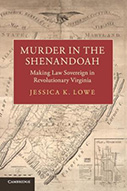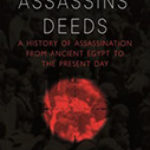Murder In The Shenandoah: Making Law Sovereign In Revolutionary Virginia

Author: Jessica K. Lowe
Publisher: New York: Cambridge University Press, 2019. 222p.
Reviewer: Michael Trotti | August 2021
It is lovely when a book lives up to or even surpasses the nice quotations in praise of it from fellow scholars. This is the craft of history masterfully realized: a case study that opens up onto a moment of transition in the law, illuminating that moment in ways deft and important. A case study, well chosen, can reflect not just upon the case but upon the era. I have rarely seen a case study so well chosen, allowing Professor Lowe to discuss the transition from Colonial law to what law would be under the new republic aborning, but also a case complex enough to make plain the whole panoply of contingent stages in the law in this moment when the law itself was in motion, with a multitude of changes in the Virginia criminal code proposed and soon to be in the offing. She uses this case in just the way a case study should be used: as a window upon a world where change was the norm.
The case itself is interesting, but in the final analysis it is, essentially, like the thread that binds together the folios of a book: thin, less important than the themes this case allows Professor Lowe to explore, yet essential to holding the whole together. It is in part the contingent nature of this murder case in northern Virginia of 1792 that allows the author so much leeway to explore law in this changing moment. A conflict in a field, a fight, a continuation of that fight later, ending in a stabbing that resulted in death. John Crane was arraigned for murdering Abraham Vanhorn. Was this self-defense or murder? Was it manslaughter – both parties responsible for the fight with the death arising out of the passions of the moment – or premeditated, or even insanity, with the documented uneven mood swings of the perpetrator offering a very different explanation of the conflict? Crucially, the jury – split by those arguing manslaughter and those believing it murder – opted not to decide, giving a special verdict: stating the facts and asking the judge to sentence the perpetrator.
By itself, this is of interest, allowing for each stage of the legal process – each evaluated in a chapter here – to be explored, its major figures outlined, and each set in the context of its moment and the inheritance of the law that Virginians found so problematic in this period. The criminal code has not yet been revised, despite strong efforts by Thomas Jefferson and others to do so in the previous decade. Many wanted a criminal code better suited to a republic (less bloody, among other things), where written laws were primary, where juries (the people) decided, and where the more informal reliance upon precedent and judicial opinion were more constrained. In this moment, a special verdict as in this case was like a demonstration of the problem that the legal systems of the new states were wrestling with after independence. Centralizing authority in judges was anathema, but would juries be capable of judging the niceties of the law adequately? This case centers our attention on this contentious terrain.
This does not even mention the many key figures of this time who had roles in this specific case – John Marshall, St. George Tucker – as well as how many of the participants in the case were in the social circles of others, particularly the northern Virginian, George Washington. And this does not mention how the footnotes could be a model for any student learning the ropes of legal history, showing how it must be built from a disparate variety of sources and given ample and painstaking context. Or how Professor Lowe carefully differentiates what firm facts we have of the case and where she is making logical inferences from other evidence we have of the era. Craft.
In an era when Shay’s Rebellion might still be considered current events and a Whiskey Rebellion was right then occurring not far away, this case reveals competing ideas of judicial authority, of what fair fighting was, of class conflict, and, most centrally to the story Professor Lowe tells, competing ideas of what the criminal law should be. Before Marbury v. Madison, it was the states that were wrestling with judicial review, and that enters this story as well.
This murder case in Berkeley County, Virginia, in 1892 might not have changed the course of legal reform itself appreciably, but it allows for a marvelous window into this moment of legal wrangling. This should become a model for legal case studies, and should be seriously considered for adoption in legal history courses.
Michael Trotti, Professor of History, Ithaca College


